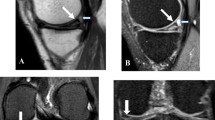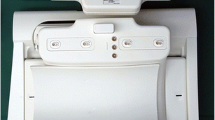Abstract
Objectives
To determine the prevalence of vacuum phenomenon (VP) in the knee on magnetic resonance (MR) images, describe the imaging features that characterize VP, and assess how often VP mimics pathological knee lesions.
Materials and methods
Consecutive knee MR studies performed on a 3 T MR system over a 9-month period were retrospectively reviewed by one radiologist who then selected studies with findings potentially indicating VP. Three experienced musculoskeletal radiologists reviewed these cases in consensus to confirm the presence of VP and to assess the shape, size, and signal of VP; the presence of magnetic susceptibility artifacts; and the ability of MR sequences to show VP.
Results
A total of 914 consecutive exams from 875 patients (524 men; mean age, 35 years) were reviewed. Vacuum phenomenon was found in 12 patients (prevalence 1.3%). In six (50%) patients, VP mimicked a meniscal tear, with four cases simulating a torn medial discoid meniscus. The VP signal was not easily differentiated from meniscal signal on most sequences in most cases (9/12). Gradient-recalled echo (GRE) localizer images proved most definitive, with 3D SPACE images the next most effective. Fast spin echo (FSE) images were only occasionally able to differentiate VP from meniscus.
Conclusion
Rarely recognized on MR, VP can mimic meniscal pathology, potentially leading to inappropriate surgery. Because differentiation of VP from the meniscus is challenging on FSE at 3 T, radiologists should become familiar with the appearance of VP and review GRE localizer or 3D images carefully to avoid misinterpretation.










Similar content being viewed by others
References
Fuiks DM, Grayson CE. Vacuum pneumoarthrography and the spontaneous occurrence of gas in the joint spaces. J Bone Joint Surg Am. 1950;32(A:4):933–8.
Virtama P. The vacuum phenomenon in knee- and shoulder-joints. Ann Chir Gynaecol Fenn. 1957;46(1):51–6.
Fick R. Manual of joint anatomy and mechanics; Part 2. Jena: Gustav Fischer; 1910:53.
Evans WA. The roentgenological demonstration of the true articular space. Am J Roentgenol. 1940;43:860–4.
Moore TM, Meyers MH, Harvey Jr JP. Collateral ligament laxity of the knee. Long-term comparison between plateau fractures and normal. J Bone Joint Surg Am. 1976;58(5):594–8.
Lee TH, Wapner KL, Mayer DP, Hecht PJ. Computed tomographic demonstration of the vacuum phenomenon in the subtalar and tibiotalar joints. Foot Ankle Int. 1994;15(7):382–5.
Resnick D, Niwayama G, Guerra Jr J, Vint V, Usselman J. Spinal vacuum phenomena: anatomical study and review. Radiology. 1981;139(2):341–8.
Novák VJ, Forrai J. On the 'vaccum phenomenon' in 20 cases. Z Ärztl Fortbild (Jena). 1963;57(2):91–3.
Dittmar O. The knee meniscus in the radiograph. Rontgenpraxis. 1932;4:422–5.
Shogry ME, Pope Jr TL. Vacuum phenomenon simulating meniscal or cartilaginous injury of the knee at MR imaging. Radiology. 1991;180(2):513–5.
Patten RM. Vacuum phenomenon: a potential pitfall in the interpretation of gradient-recalled-echo MR images of the shoulder. AJR Am J Roentgenol. 1994;162(6):1383–6.
Miller MD, Osborne JR. Spontaneous vacuum pneumarthrography revisited: the significance of the vacuum phenomenon in the lateral compartment of the knee. Arthroscopy. 1998;14(6):576–9.
Nordheim Y. A new method to visualize cartilage, specifically knee meniscii, using radiography (without the help of injected contrast). Fortechr Rontgenmtr. 1938;57:479–95.
Gershon-Cohen J, Schraer H, Sklaroff DM, Blumberg N. Dissolution of the intervertebral disk in the aged normal; the phantom nucleus pulposus. Radiology. 1954;62(3):383–7.
Martel W, Poznanski AK. The value of traction during roentgenography of the hip. Radiology. 1970;94(3):497–503.
Greenough CG. The vacuum arthrogram in the acutely injured knee: a case report. J Trauma. 1989;29(3):401–2.
Wright DM, Sochart DH. Spontaneous vacuum phenomenon in the lateral compartment of the knee associated with a lateral tibial plateau fracture. Knee. 2006;13(1):42–4.
Middleton WD, McAlister WH. Hip joint fluid in the presence of the vacuum phenomenon. Pediatr Radiol. 1986;16(2):171–2.
Laczay A, Csapó K. The vacuum phenomenon in the knee joint. Rontgenblatter. 1974;27(6):315–20.
Sochart DH, Amr M, Paul AS. Meniscal vacuum phenomenon—a radiographic sign diagnostic of meniscal tear. Knee. 1997;4(2):105–8.
Jordanov MI, Block JJ. Minute amounts of intraarticular gas mimicking torn discoid lateral menisci. J Magn Reson Imaging. 2010;31(3):698–702.
Busse RF, Brau AC, Vu A, Michelich CR, Bayram E, Kijowski R, et al. Effects of refocusing flip angle modulation and view ordering in 3D fast spin echo. Magn Reson Med. 2008;60(3):640–9.
Busse RF, Hariharan H, Vu A, Brittain JH. Fast spin echo sequences with very long echo trains: design of variable refocusing flip angle schedules and generation of clinical T2 contrast. Magn Reson Med. 2006;55(5):1030–7.
Gold GE, Busse RF, Beehler C, Han E, Brau AC, Beatty PJ, et al. Isotropic MRI of the knee with 3D fast spin-echo extended echo-train acquisition (XETA): initial experience. AJR Am J Roentgenol. 2007;188(5):1287–93.
Yoshida H, Shinomiya K, Nakai O, Kurosa Y, Yamaura I. Lumbar nerve root compression caused by lumbar intraspinal gas. Report of three cases. Spine. 1997;22(3):348–51.
Thomas SF, Williams OL. High-altitude joint pains (bends): their roentgenographic aspects. Radiology. 1945;44:259–61.
Ford LT, Gilula LA, Murphy WA, Gado M. Analysis of gas in vacuum lumbar disc. AJR Am J Roentgenol. 1977;128(6):1056–7.
Roston JB, Haines RW. Cracking in the metacarpo-phalangeal joint. J Anat. 1947;81(Pt 2):165–73.
Hippe H, Hähle K. In question of the true joint space. Röntgenpraxis. 1938;8:98–9.
Malghem J, Maldague B, Labaisse MA, Dooms G, Duprez T, Devogelaer JP, et al. Intravertebral vacuum cleft: changes in content after supine positioning. Radiology. 1993;187:483–7.
Wood L, Ferrell WR, Baxendale RH. Pressures in normal and acutely distended human knee joints and effects on quadriceps maximal voluntary contractions. Q J Exp Physiol. 1988;73(3):305–14.
Spencer JD, Hayes KC, Alexander IJ. Knee joint effusion and quadriceps reflex inhibition in man. Arch Phys Med Rehabil. 1984;65(4):171–7.
Levick JR. Microvascular architecture and exchange in synovial joints. Microcirculation. 1995;2(3):217–33.
Löhr R, Hellpap W. The knee joint space in radiograph. Fortschr Geb Röntgenstrahlen. 1938;58:45–56.
Herman LJ, Beltran J. Pitfalls in MR imaging of the knee. Radiology. 1988;167(3):775–81.
Oei EH, Ginai AZ, Hunink MG. MRI for traumatic knee injury: a review. Semin Ultrasound CT MR. 2007;28(2):141–57.
Watanabe AT, Carter BC, Teitelbaum GP, Bradley Jr WG. Common pitfalls in magnetic resonance imaging of the knee. J Bone Joint Surg Am. 1989;71(6):857–62.
Zanetti M, Pfirrmann CW. Pitfalls in magnetic resonance imaging of the knee. Radiologe. 2006;46(1):71–7.
Fox MG. MR imaging of the meniscus: review, current trends, and clinical implications. Radiol Clin North Am. 2007;45(6):1033–53.
Manmaster BJ, Newman A. A practical guide for MR interpretation of knee menisci. Part I: Normal anatomy and criteria for diagnosis of meniscal tears. Radiologist. 1994;1:209–16.
Stoller DW, Li AE, Anderson LJ, Cannon DW. The knee. In: Stoller DW, editor. Magnetic resonance imaging in orthopaedics and sports medicine, 3rd ed. Philadelphia: Lippincott Williams & Wilkins; 2007. p. 305–731.
Rubin DA. MR imaging of the knee menisci. Radiol Clin North Am. 1997;35(1):21–44.
McKnight A, Southgate J, Price A, Ostlere S. Meniscal tears with displaced fragments: common patterns on magnetic resonance imaging. Skeletal Radiol. 39(3):279–83.
Helms CA, Laorr A, Cannon Jr WD. The absent bow tie sign in bucket-handle tears of the menisci in the knee. AJR Am J Roentgenol. 1998;170(1):57–61.
Haramati N, Staron RB, Rubin S, Shreck EH, Feldman F, Kiernan H. The flipped meniscus sign. Skeletal Radiol. 1993;22(4):273–7.
Lecas LK, Helms CA, Kosarek FJ, Garret WE. Inferiorly displaced flap tears of the medial meniscus: MR appearance and clinical significance. AJR Am J Roentgenol. 2000;174(1):161–4.
Ruff C, Weingardt JP, Russ PD, Kilcoyne RF. MR imaging patterns of displaced meniscus injuries of the knee. AJR Am J Roentgenol. 1998;170(1):63–7.
Chen HC, Hsu CY, Shih TT, Huang KM, Li YW. MR imaging of displaced meniscal tears of the knee. Importance of a "disproportional posterior horn sign". Acta Radiol. 2001;42(4):417–21.
Kim SJ, Seo YJ. Bilateral discoid medial menisci: incomplete type in one knee and complete type in opposite knee. Knee. 2006;13(3):255–7.
Dickason JM, Del Pizzo W, Blazina ME, Fox JM, Friedman MJ, Snyder SJ. A series of ten discoid medial menisci. Clin Orthop Relat Res. 1982;168:75–9.
Papadopoulos A, Karathanasis A, Kirkos JM, Kapetanos GA. Epidemiologic, clinical and arthroscopic study of the discoid meniscus variant in Greek population. Knee Surg Sports Traumatol Arthrosc. 2009;17(6):600–6.
Acknowledgments
We thank Bethany Casagranda (casagrandab@upmc.edu) who emphasized the importance of the interlocking key sign to us. We appreciate the assistance provided by Ms. Megan Griffiths, scientific writer for the Imaging Institute, in the preparation and submission of this manuscript. We thank Dr. Erika Schneider for translating the German articles. I wish to dedicate this manuscript to Piran Aliabadi, MD, for first demonstrating to me that vacuum phenomenon can occur in the presence of a joint effusion.—CSW
Conflicts of interest
The authors declare that they have no conflicts of interest.
Author information
Authors and Affiliations
Corresponding author
Rights and permissions
About this article
Cite this article
Sakamoto, F.A., Winalski, C.S., Schils, J.P. et al. Vacuum phenomenon: prevalence and appearance in the knee with 3 T magnetic resonance imaging. Skeletal Radiol 40, 1275–1285 (2011). https://doi.org/10.1007/s00256-011-1192-5
Received:
Revised:
Accepted:
Published:
Issue Date:
DOI: https://doi.org/10.1007/s00256-011-1192-5




